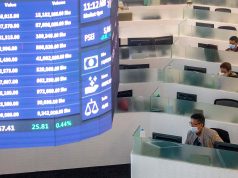December inflation fastest in six months
By Marissa Mae M. Ramos
Researcher
THE OVERALL year-on-year increase in prices of widely used goods picked up for the second straight month in December by its fastest pace in six months, the government reported on Tuesday.
Despite last year’s steady inflation, economists flagged risks to the inflation trend this year, most notably geopolitical tensions in the Middle East that may send global oil prices soaring.
Preliminary data from the Philippine Statistics Authority (PSA) showed headline inflation at 2.5% last month, marking the fastest pace since June’s 2.7%, albeit still slower than the 5.1% in December 2018.
The December figure is higher than the 2.1% median in a BusinessWorld poll conducted late last week and falls near the high end of the 1.8-2.6% estimate given by the Bangko Sentral ng Pilipinas (BSP).
Full-year inflation came in at 2.5% against the BSP’s 2-4% target range for 2019 and its full-year forecast of 2.4%. This was slower than the 5.2% average inflation rate posted in 2018 and marked the slowest since 2016’s 1.3%
Core inflation, which discounted volatile prices of food and fuel, stood at 3.1% in December, picking up from 2.6% the previous month and the fastest since the 3.2% in July 2019.
For the entire year, core inflation averaged 3.2%, slower than 2018’s 4.2%.
In a statement, the PSA attributed the December inflation uptrend mainly to the 1.7% year-on-year increase in the heavily weighted food and non-alcoholic beverages index from zero percent.
The transport index posted an annual increase of 2.2% in December versus the 2.4% contraction in November.
Other indices with faster annual markups include alcoholic beverages and tobacco (to 18.4% from 17.6%); furnishing, household equipment and routine maintenance of the house (3.1% from 2.8%); and housing, water, electricity, gas and other fuels (1.9% from 1.2%).
The food-alone index posted a 1.7% inflation rate, a reversal from November’s 0.2% decline, albeit slower than the 6.3% a year ago.
Driving food inflation were fish and vegetables, which saw higher annual rate increases of 7.4% in December (from 2.5% in November), and 8.2% (from one percent), respectively. Other food commodities that accelerated during the period were milk, cheese and egg (3.3% from 3.2%), and food products “not elsewhere classified” (6.3% from 5.6%).
Notably, rice posted an annual decline of 6.8% in December — its eighth straight month of contraction even as this was slower than November’s 8.3% decline.
“Base effects from the 2018 price spike have all but faded out, pushing December headline inflation well-past market expectations…,” said ING Bank NV-Manila Senior Economist Nicholas Antonio T. Mapa in a note to reporters.
For Security Bank Corp. Chief Economist Robert Dan J. Roces: “The uptick means two things, namely that the 2018 base effects have dissipated and second, that household consumption is strong and this bodes well for the fourth-quarter growth in 2019,” he said in an e-mail to BusinessWorld.
In a separate e-mail, UnionBank of the Philippines, Inc. Chief Economist Ruben Carlo O. Asuncion said seasonal demand, higher utility costs, recent weather disturbances, and rising demand of alternatives to pork products due to the African Swine Fever (ASF) scare have “magnified the higher-than-expected inflation uptick” in December.
RISKS AND OUTLOOK
In a statement, the BSP noted the latest inflation result was “consistent” with its assessment of inflation approaching the midpoint of the 2-4% target range in 2020 until 2022.
The central bank added that the risks to the inflation outlook are “on the upside” for this year, but are “tilted to the downside” in 2021, citing volatility in global prices and the potential impact of the ASF outbreak as the main upside risks to inflation.
“Meanwhile, the impact of global trade and policy uncertainty as well as geopolitical tensions continue to be the main downside risks to inflation,” the BSP statement further read.
In a statement by the National Economic and Development Authority, Socioeconomic Planning Secretary Ernesto M. Pernia said that despite the last year’s steady inflation, the government must “remain vigilant and proactive” in managing the impact of “potential price pressures” this year.
Mr. Pernia also noted the escalating tension in the Middle East may disrupt global oil supply, which could lead to a surge in overall inflation.
“Though considered benign, recent geopolitical developments in Iran and Iraq may have warranted a re-evaluation as Middle East tensions continue to rise,” UnionBank’s Mr. Asuncion said.
Mr. Asuncion said that UnionBank’s Economic Research Unit expects 2020 inflation at 2.8%, but noted the government’s inflation forecast of 2-4% may be breached if these geopolitical issues persist and push prices higher than the government’s Dubai crude oil price assumption of $55-70 per barrel for 2020.
“Although it seems that inflation in 2019 has settled at 2.5% and well-within the government’s current inflation target, the Monetary Board may have to let these volatile situations simmer down… and until then, evaluate again if easing further is indeed the way to go,” he added.
ING Bank’s Mr. Mapa expects inflation to “edge higher in 2020” as “reverse base effects” kick in along with the scheduled excise tax of fuel products sometime early this year.
“This moves in line with our expectation for inflation to ‘bounce then settle’ with headline inflation rising back to the 3% handle and remain stable for the rest of 2020. Factoring the reverse base effects, we expect inflation to average 3.2% and as high as 3.4% should oil prices edge higher due to possible supply-side disruptions,” he added.
“We continue to believe that the BSP will have the scope to ease monetary policy further in 2020 with the first rate cut slated for the February [policy] meeting,” he said.
For Security Bank’s Mr. Roces: “[W]e think the BSP will resume monetary easing within the first quarter and probably near the end of the quarter.”
“The data-dependent BSP will want to gauge first and foremost developments in the Middle East, see where it’s headed, and proceed from there. But considering inflation levels, benign price growth will spur a cut,” he said.
The Monetary Board will meet on Feb. 6 to discuss policy.




